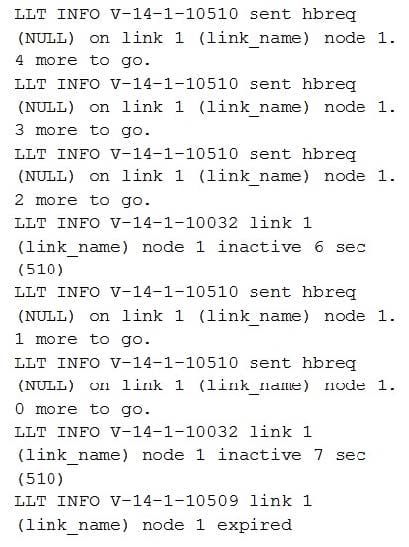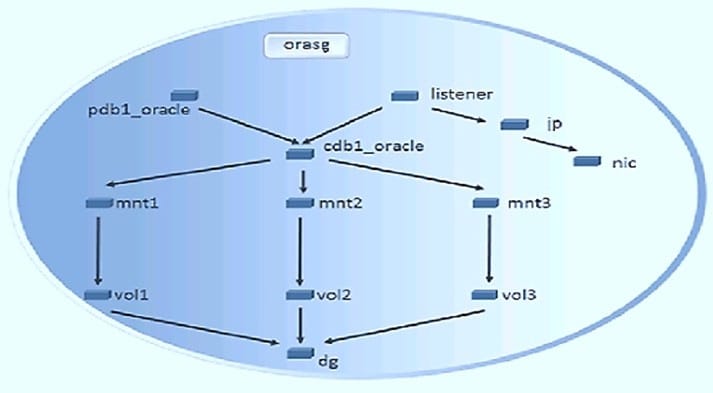Exam Details
Exam Code
:VCS-260Exam Name
:Administration of Veritas InfoScale Availability 7.3 for UNIX/LinuxCertification
:Veritas CertificationsVendor
:VeritasTotal Questions
:80 Q&AsLast Updated
:Apr 27, 2025
Veritas Veritas Certifications VCS-260 Questions & Answers
-
Question 61:
An administrator wants to deploy a complex cluster configuration that will include over six nodes, I/O fencing, and multiple private cluster interconnections.
Which method will help the administrator to implement rapid cluster deployment?
A. prepare a custom main.cf file using the sample template files and copy the file to all cluster nodes
B. generate a custom installation script using the Veritas Services and Operations Readiness Tools (SORT) website
C. prepare a custom response file in Veritas InfoScale Operations Manager (VIOM) and push it out to the new cluster
D. prepare a custom response file to build the new cluster configuration using /opt/VRTS/install/installer
-
Question 62:
Which two resource attributes must the administrator set correctly to prevent a fault for the service group when a new resource is added? (Choose two.)
A. AutoDisabled
B. Critical
C. Enabled
D. Frozen
E. MonitorOnly
-
Question 63:
While reviewing the system logs, an administrator notices the following entries on a previously running cluster node:

Which two actions should the administrator take to determine and resolve the issue? (Choose two.)
A. check whether the link has become physically disconnected from the system or switch
B. check the contents of the /etc/llttab file
C. verify the NIC agent is started
D. forcefully restart llt with lltconfig
E. check the NIC/link health and replace the NIC/link if necessary
-
Question 64:
Refer to the exhibit.
In a three-node cluster, the orasg service group is online on one of the systems. The service group has the resources and resource dependencies shown in the exhibit. All resources are critical resources and the following service group attributes have been configured:
1.
ManageFaults = ALL
2.
FaultPropagation = 0
3.
AutoFailOver = 1
What is the expected behavior when the mnt2 resource fails?

A. The service group fails over to one of the other systems in the cluster.
B. The service group is taken offline and remains offline in the cluster.
C. The mnt2 resource is taken offline, all other resources remain online.
D. The mnt2 resource and all its parent resources are taken offline, the rest remain online.
-
Question 65:
An administrator is evaluating the suitability of an application to be clustered which can failover to another node in the cluster in an event of an application outage using Veritas InfoScale Availability.
Which condition prevents the application from being made highly available?
A. The application requires the use of solid state drives for performance.
B. The cluster is NOT configured with public low priority link.
C. Individual unique instances of the application cannot be monitored on the system the application is running.
D. After a crash, the automated clean-up takes at least one minute before the application can be restarted.
-
Question 66:
How is the Authority attribute of a global service group used?
A. to authorize the users who have the administrative privileges over the global service group
B. to authorize the cluster on which all administrative actions should be performed for the global service group
C. to give authority for automated failover of the global service group across remote clusters
D. to specify the right to attempt brining the global service group online in the cluster
-
Question 67:
As part of the consolidation efforts in a data center, the administrator decides to merge two two-node Veritas Cluster Server (VCS) clusters into a four-node VCS cluster. The source and target clusters are on the same networks for LLT communication. The administrator performs the following task as preparation for the merge while both clusters are still running:
1.
modifies /etc/llttab files on the source cluster systems so the cluster ID is changed to the cluster ID of the target cluster
2.
modifies /etc/llthosts files on all systems to include the four nodes
3.
modifies /etc/gabtab files on all systems to require four systems to seed
4.
ensures the source cluster systems can see the fencing disks used by the target cluster
5.
copies the fencing configuration files from the target cluster systems to the source cluster systems
6.
adds the source cluster systems to the target cluster configuration using the hasys -add command
After the preparation is complete, the administrator stops the source cluster leaving the applications running, then stops the whole communication stack and restarts it in the correct order. When the administrator attempts to start the cluster again on the source cluster systems, they fail to join the four-node cluster.
Which preparation step that the administrator failed to perform is preventing the source cluster systems from joining the four-node cluster?
A. The cluster needs to be manually seeded using gabconfig -x on the source cluster systems.
B. The target main.cf file needs to be copied to the source cluster systems.
C. The service group configuration of the source cluster needs to be applied to the target cluster.
D. The cluster UUID from the target cluster needs to be copied to the source cluster.
-
Question 68:
Consider the following service group configuration from main.cf

Both groups are online on server1, and the administrator executes the following command.

What is the result?
A. The user is prompted to take group appsg offline.
B. Group appsg and group dbsg both go offline.
C. The user receives an error about the group dependency.
D. Group dbsg goes offline.
-
Question 69:
An administrator wants to place an existing application under high availability control. Which requirement must be met to place the application under high availability control?
A. The application must have defined start, stop, and monitor procedures.
B. The application must have an unlimited license model.
C. The application must have an enterprise agent available on SORT.
D. The application must run in kernel space.
-
Question 70:
Which attribute can an administrator configure to allow a service group to come back online after a persistent resource has faulted and other nodes are unavailable?
A. RestartLimit
B. AutoRestart
C. FailOverPolicy
D. AutoStartPolicy
Related Exams:
VCS-256
Administration of Veritas InfoScale Availability 7.1 for UNIX/LinuxVCS-257
Administration of Veritas InfoScale Storage 7.1 for UNIX/LinuxVCS-260
Administration of Veritas InfoScale Availability 7.3 for UNIX/LinuxVCS-261
Administration of Veritas InfoScale Storage 7.3 for UNIX/LinuxVCS-275
Administration of Veritas NetBackup 7.7 and NetBackup Appliances 2.7VCS-276
Administration of Veritas NetBackup 8.0VCS-277
Administration of Veritas NetBackup 8.0 and NetBackup Appliances 3.0VCS-278
Administration of Veritas NetBackup 8.1.2VCS-279
Administration of Veritas NetBackup 8.1.2 and NetBackup Appliances 3.1.2VCS-285
Veritas NetBackup 10.x and NetBackup Appliance 5.x Administrator
Tips on How to Prepare for the Exams
Nowadays, the certification exams become more and more important and required by more and more enterprises when applying for a job. But how to prepare for the exam effectively? How to prepare for the exam in a short time with less efforts? How to get a ideal result and how to find the most reliable resources? Here on Vcedump.com, you will find all the answers. Vcedump.com provide not only Veritas exam questions, answers and explanations but also complete assistance on your exam preparation and certification application. If you are confused on your VCS-260 exam preparations and Veritas certification application, do not hesitate to visit our Vcedump.com to find your solutions here.